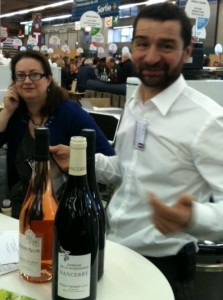It’s Friday and we’re making our yearly trip to the Independant Wine Growers’ Fair in Paris at Porte de Versailles. We are surprised to find plenty of empty parking spaces in the back street we usually use to avoid the large crowds waiting to take the lift to the underground parking area. For once, there isn’t another fair at the same time.

We trade our free invitation for two glasses celebrating the 35th anniversary of the fair. We have a very large stock of these INAO glasses now, which is great for parties. We snap them into our nifty glass holders so we have our hands free.
Having checked out our wine list beforehand, we know we need sancerre, a Loire Valley sauvignon, for our spéciales oysters, quincy, another, less well-known Loire Valley sauvignon for fish and corbières from Languedoc-Roussillon in the south of France for lamb grilled on the open fire. We’ve run out of minervois in the Carcassonne area which is also great with lamb but our wine grower seems to have disappeared to our dismay.
We use the list of wines and growers on the wall to work out the order in which we are going to make our purchases because the Fair is enormous.

François Cherrier is first on the list. We have been buying his sancerre since we first visited his vineyard ten years ago. He and his wife welcome us and we taste their range of whites but settle, as usual, for their delicious Essentiel at 9.60 euro / bottle. We explain we are moving to the Loire and learn that they have close family in Blois so will be able to stock up again very easily. What wonderful news!

We buy our quincy Cuvée Tradition from Domaine Jacques Rouzé at 7.30 euro a bottle and decide it’s time for our traditional foie gras sandwich.

Jean Michel parks the trolley near a bench at the far end where other people are eating sandwiches as well and says I can sit on it. How very useful ! It’s just the right height. We notice that our neighbours have a very strange carton so I ask them if it’s a special wine. No, it’s just the box that is unusual.

It turns out that Brian is Irish and that he and his French wife live near the Marne in an area where we have often cycled. We have an enjoyable discussion about children and bilingualism and the different countries they have lived in.

The last wine grower on our list is Domaine du Grand Arc. We buy two types of sun-drenched corbières – Cuvée des Quarante which we bought last time (7.90 euro), a combination of 45% carignan, 35% grenache noir and 20% shiraz and En sol majeur (11.50 euro) which is 60% grenache noir and 40% shiraz. We see it has a “heart” in the 2014 Hachette wine guide.
As we are leaving, I spy a sign for minervois. Shall we try ? Château de l’Amiral turns out to be a lucky stab in the dark. The 7th generation wine grower is a woman whose praises are sung by her husband who is running the stand. She uses a special process he calls macération carbonique for her Cuvée Prestige.

We both look at him in amazement while he explains that the historical grape varieties of minervois, carignan and grenache are vinified together using carbonic maceration. The whole bunches are placed carefully in a closed vat so the grapes don’t burst which means that the juice ferments inside the grape expressing its unique, typical aromas. The air in the tank is replaced with CO2 from the fermentation taking place in other vats to prevent the wine from oxidising. This mini-vintage is limited to 3,400 bottles.
We love the result with its red berry nose, dense, rich tanins and very nice balance. At 18 euro a bottle, it’s excellent value for money!
Domaine de la Rossignole, rue de la Croix Michaud, 18300 Verdigny, Tel 02 48 79 34 93 cherrier@easynet.fr Domaine Jacques Rouzé, 18120 Quincy. Tel +33 248 513 561 rouze@terre-net.fr, http://www.jacques-rouze.com Domaine du Grand Arc, Fabienne et Bruno SCHENCK, Le Devez, 11350 CUCUGNAN, Tel/Fax: 0468450103, domaine.grandarc@gmail.com, http://www.grand-arc.fr Château l’Amiral 14, avenue de l’Amiral Gayde 11800 AIGUES-VIVES 06 83 51 68 88 contact@chateaulamiral.fr http://www.chateaulamiral.fr/














